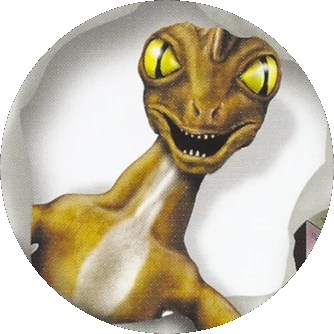Hesperornis zoomed through the seas 90 million years ago to catch prey, but this creature wasn't a fierce fish. Hesperornis was a bird. Its body was built like a torpedo-long and thin to slice through water with little resistance. Dozens of small teeth in its skull make scientists think the animal evolved from the dinosaurs.
See Life: A big set of eyes that were likely covered with specialized lenses helped this bird see well underwater. Also, glands above hesperornis' eye sockets helped excrete the salt from seawater that the bird swallowed while hunting.
Needle Nose: Hesperornis had a long, slim beak that, unlike modern birds, was studded with dozens of small teeth. These not only killed prey, but also helped the ancient bird grip victims in its mouth so they couldn't escape.
Your Daddy Was a Dino![]

This perfectly preserved fossil shows the sleek frame that made this prehistoric bird a great swimmer.
What puzzles scientists the most about hesperornis is figuring out what its ancestors were. The fact that the creature's jaws were lined with teeth and its bones were thick and heavy tells experts that it evolved from reptiles, such as the flying pterosaurs or marine reptiles, such as the mosasaurs. Either would make sense, but hesperornis' skeleton was very similar to that of dinosaurs, such as velociraptor. Experts believe that it's possible that all birds, including hesperornis, evolved from these dinosaurs.
Time to Turn: This bird couldn't fly. Hesperornis' wings were stubby and nowhere near strong enough to power flight. Instead, they made great rudders for swerving in tight turns through the water while the creature propelled itself with its webbed feet.
Water Foul: Hesperornis spent almost all its life out at sea. The creature couldn't fly at all or even walk very well, so it came on land only to breed, scooting onto the sand or up rocks in mass numbers for just a few days every year.
Calamari for Lunch[]
- As it does with most of its day, a hesperornis floats on the surface of the sea, searching for prey. A pteranodon flies overhead, looking for fish near the surface. The bird has a better choice of prey, as it can grab fish from far below the surface.
- A quick flash from below sends the hesperornis into a dive. The bird paddles furiously, matching every twist and turn the squid makes by steering with its wings. The hunter quickly catches its prey and kills it with a few bites.
Trading Card[]
Trivia[]
- The back of the card features a Pteranodon.
- The hesperornis is featured in Fossil Finders on Monster Mania 56.
- The skull used for the game is also featured on the back of the knowledge card.
